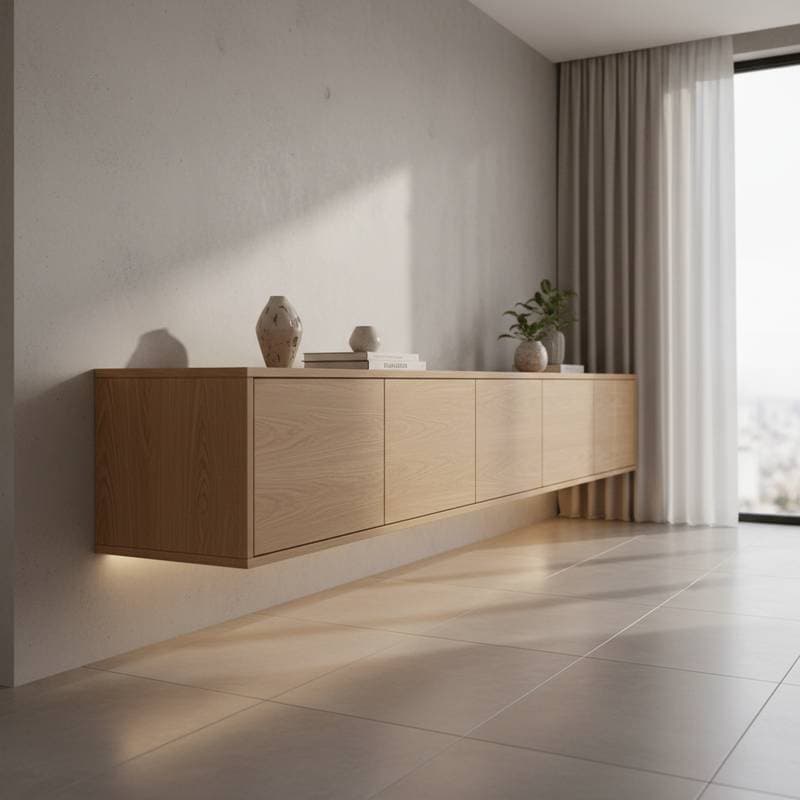The Rise of Floating Credenzas: Replacing Base Cabinets in 2025
Floating credenzas gain prominence as a preferred choice over traditional base cabinets. Homeowners and interior designers favor these wall-mounted storage solutions for their streamlined profiles, adaptable positioning, and airy aesthetic. A typical floating credenza ranges in cost from $1,200 to $3,800, influenced by material selections and dimensions, yet delivers a bespoke, integrated appearance that ground-level cabinetry often lacks.
This transition reflects broader preferences for functional, uncluttered spaces. Designers highlight how these units align seamlessly with contemporary, mid-century modern, and minimalist design schemes. The result enhances room proportions while addressing practical needs in diverse living environments.
At a Glance
- Average cost: $1,200 to $3,800
- Installation time: 4 to 8 hours
- Skill level: Intermediate carpentry
- Popular widths: 60 to 96 inches
- Wall support: Stud anchors or French cleats rated for 250 pounds or more
Reasons Floating Credenzas Surpass Base Cabinets
Conventional base cabinets occupy valuable floor area and create a grounded, heavy visual presence in any room. In contrast, floating credenzas suspend several inches above the floor, liberating the space below for easier cleaning and movement. This elevation fosters a lighter atmosphere, particularly beneficial in compact apartments or expansive open-plan layouts.
Flexibility stands out as a key advantage. Users adjust the height to suit specific functions, such as a low 20-inch media console or a taller 32-inch dining storage option. Such versatility proves ideal for urban condos where every square foot counts toward livability.
Practical benefits further drive adoption. Wall anchoring allows integration with baseboard heating systems or conceals wiring without obstruction. When secured to studs or reinforced with high-capacity cleats, these credenzas bear loads from 150 to 300 pounds, ensuring reliability for dishes, books, or electronics.
Action Step
Prior to purchasing, employ a stud finder to map wall framing and verify load-bearing capacity of the surface, typically drywall over wooden studs. Install a plywood backer board to bolster support if heavy storage is anticipated.
Installation Process Overview
Mounting a floating credenza demands accuracy but proves less complex than constructing full cabinet systems. The procedure emphasizes secure attachment and precise alignment to prevent future issues.
Basic process:
- Mark desired height on the wall and locate stud positions.
- Secure blocking or a full backer board across the span.
- Fasten a French cleat or heavy-duty steel rail to the wall.
- Position and level the credenza body onto the mount.
- Install doors, drawers, and fine-tune for even alignment.
Projects for a standard unit require 4 to 8 hours. Units exceeding 8 feet in length necessitate assistance from a second person to manage lifting and stabilization. Select hardware capable of supporting at least double the anticipated weight for safety.
Why It Works
Elevating the credenza above the floor shields it from moisture accumulation and simplifies upkeep. This arrangement also directs visual focus upward, creating an illusion of greater ceiling height and expanded room dimensions.
Action Step
Enlist a helper for the lifting phase. Drill pilot holes in advance and opt for lag screws or toggle bolts suited to the wall composition. Verify levelness after installing each fastener to avoid any uneven settling.
Cost Breakdown and Budgeting
Prices for floating credenzas fluctuate based on specifications and craftsmanship. Ready-made options begin around $1,200, whereas bespoke versions in premium woods like walnut or oak climb to $3,800 or $5,000. Additional expenses for hardware and wall preparation typically add $150 to $300.
Key price influencers:
- Dimensions, including width and depth
- Construction materials, ranging from engineered MDF to solid hardwoods
- Quality of components such as drawer slides, hinges, and surface finishes
- Robustness of the mounting hardware
Opt for modular, assemble-yourself designs paired with upgraded fittings to control expenses. Prioritize investment in the anchoring system, as inadequate mounts represent the primary vulnerability in these installations.
Action Step
Allocate at least 15 percent of the overall budget for labor or equipment rentals. The mounting quality directly impacts the installation's longevity and structural integrity.
Choosing Between DIY and Professional Help
Individuals with intermediate woodworking experience and proficiency in wall fixtures find DIY feasible. Essential tools include a power drill, spirit level, stud detector, and impact driver. Allocate approximately half a day for completion.
Engage a professional carpenter under these conditions:
- Walls feature irregularities or concealed utilities like plumbing.
- The credenza exceeds 150 pounds in weight.
- A flawless, integrated finish is desired.
Rates for expert installation average $350 to $600, encompassing supplies and adjustments.
Action Step
Request evidence of liability insurance and client testimonials from any hired professional. A competent installer assesses stud alignment, weight tolerances, and surface integrity prior to commencing work.
Pitfalls to Sidestep in Installation
Inadequate wall reinforcement leads to instability, even with superior anchors. Exceeding specified weight capacities by storing dense items like cookware invites structural failure. Uneven leveling manifests prominently once hardware is added, compromising aesthetics.
Overlooking clearance below the unit hinders cleaning and ventilation. Maintain at least a half-inch gap from the floor to accommodate these needs.
Action Step
Employ a laser level for precise markings and recheck after securing both ends. Should flexing or noise occur upon testing, dismount the unit immediately and strengthen the wall attachment.
Implementing Your Floating Credenza Project
Begin by measuring stud intervals and selecting an optimal mounting elevation based on room use. Evaluate both off-the-shelf and tailored options against your financial parameters. Schedule adequate time and secure assistance as required.
Select surface treatments that harmonize with existing elements like adjacent cabinets or floor coverings. This cohesive approach amplifies the modern appeal while ensuring practical functionality. Homeowners report heightened satisfaction from the added spaciousness and ease of maintenance these installations provide.
